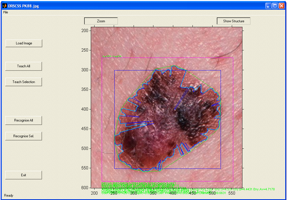ORSCSS (Oxford Recognition Skin Cancer Screening System Solutions)
Malignant Melanomas are increasingly common, a potentially fatal form of skin cancer the incidence of which is increasing at a rate greater than any other form of cancer. It is difficult to visually differentiate a normal mole from abnormal, and GP’s do not have sufficient expertise to diagnose skin cancer. Cancer specialists improve the identification rate to over 80% but are severely overloaded with work worldwide.

Fractal Geometry
Classical geometry deals with mathematically simple forms such as spheres, cones, cubes etc. These simple and exact forms, however, rarely occur naturally. A geometry suitable for describing natural objects was developed in the last century and has only relatively recently been researched properly. This revolutionary field known as Fractal Geometry deals with shapes of infinite detail, such as coastlines, the branching of a river delta or nebulous forms of clouds. It allows the definition and measurement of the properties of such objects.
Feature Detection
For each object, a set of recognition features are detected. The features are numeric parameters that describe the object. ORSCSS captures a variety of geometrical, fractal and statistical features in 1 and 2 dimensions. 1D features correspond to the border of mole, whereas 2D features relate to the surface within and around the mole. Additionally, ORSCSS analyses the mole i.e. its growth stages.

Decision Making
The system uses fuzzy logic to combine features into a decision. A decision is the estimated class of object and accuracy probability. ORSCSS has two classes of moles: normal and abnormal. In-between states are determined by the probability. For example, 35% normal is equivalent to 65% abnormal and suggests careful analysis by cancer specialists. In cervical cancer, there are 7 or more classes (CINs) depending on the classification system.


